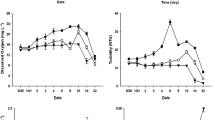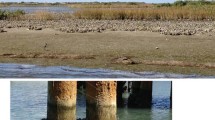Abstract
Asterias amurensis is a starfish native to the northern Pacific that was introduced into southern Australia in the 1980s. It is widely viewed as one of Australia’s most serious invasive marine pests, but there are few methods available to control new or established populations. The role of Coscinasterias muricata in controlling the distribution of Asterias in Port Phillip Bay, and its potential to eliminate new infestations of Asterias were investigated. Laboratory feeding trials, where alternative mussel prey were available, showed Coscinasterias consumed Asterias at the rate of ~45/year. Field surveys in Port Phillip Bay showed that most Coscinasterias occurred at depths shallower than 15 m, while most Asterias occurred at depths greater than 15 m, and the ratio of Asterias/Coscinasterias only exceeded 45 at depths greater than 15 m. Consequently, if laboratory and field feeding rates are similar, Coscinasterias would be expected to exert significant control over Asterias populations at depths shallower than 15 m, and augmenting Coscinasterias populations at sites of new Asterias infestations may help eliminate newly-established populations.





Similar content being viewed by others
References
Atalah J, Hopkins GA, Forrest BM (2013) Augmentative biocontrol in natural marine habitats: persistence, spread and non-target effects of the sea urchin Evechinus chloroticus. PLoS ONE 8:1–10
Atalah J, Newcombe EM, Zaiko A (2016) Biocontrol of fouling pests: effects of diversity, identity and density of control agents. Mar Environ Res 115:20–27
Barker MF (1977) Observations on the settlement of the brachiolaria larvae of Stichaster australis (Verrill) and Coscinasterias calamaria (Gray) (Echinodermata: Asteroidea) in the laboratory and on the shore. J Exp Mar Biol Ecol 30:95–108
Barker MF (2013) Coscinasterias. In: Lawrence JM (ed) Starfish biology and ecology of the Asteroidea. John Hopkins UP, Baltimore, pp 191–199
Barker MF, Nichols D (1983) Reproduction, recruitment and juvenile ecology of the starfish, Asterias rubens and Marthasterias glacialis. J Mar Biol Assoc UK 63:745–765
Botsios L (2001) Evaluation of potential predators of Asterias amurensis (northern Pacific starfish) in Port Phillip Bay. B.Sc. (Hons) Thesis, School of Ecology & Environment, Deakin University, Warrnambool Campus
Byrne M, O’Hara TD, Lawrence JM (2013) Asterias amurensis. In: Lawrence JM (ed) Starfish biology and ecology of the Asteroidea. John Hopkins UP, Baltimore, pp 174–180
Day R, Dowell A, Sant G, Klemke J, Shaw C (1995) Patchy predation: foraging behaviour of Coscinasterias calamaria and escape responses of Haliotis rubra. Mar Freshw Behav Physiol 26:11–33
Dayton PK, Rosenthal RJ, Mahen LC, Antezana T (1977) Population structure and foraging biology of the predaceous Chilean asteroid Meyenaster gelatinosus and the escape biology of its prey. Mar Biol 39:361–370
Grannum RK, Murfet NB, Ritz DA, Turner E (1996) The distribution and impact of the exotic seastar, Asterias amurensis (Lutken) in Tasmania. Final report to Australian Nature Conservation Agency Feral Pests Program Number 56
Hancock DA (1955) The feeding behaviour of starfish on Essex oyster beds. J Mar Biol Assoc UK 34:313–331
Hayes K, Sliwa C, Migus S, McEnnulty F, Dunstan P (2005) National priority pests: Part II Ranking of Australian marine pests. A report to Department of Environment and Heritage by CSIRO Marine Research, Feb 2005
Hirst A, Bott N, Lee R (2013) Plankton survey of Asterias amurensis larvae in coastal waters of Victoria (August–September 2012)—final report. Fisheries Technical Report 178, Department of Primary Industries, Queenscliff, VIC, Australia
Hughes WD (1973) Operational tests of Victorian scallop boats. Aust Fish 33(5):14–16
Hutson KS, Ross DJ, Day RW, Ahern JJ (2005) Australian scallops do not recognise the introduced predatory seastar Asterias amurensis. Mar Ecol Prog Ser 298:305–309
Keough MJ, Butler AJ (1979) The role of asteroid predators in the organisation of a sessile community on pier pilings. Mar Biol 51:167–177
Mauzey KP, Birkeland C, Dayton PK (1968) Feeding behaviour of asteroids and escape responses of their prey in the Puget Sound region. Ecology 49:603–619
McClintock JB, Lawrence JM (1984) Ingestive conditioning in Luidia clathrata (Say) (Echinodermata: Asteroidea): effect of nutritional condition on selectivity, teloreception and rates of ingestion. Mar Behav Physiol 10:167–181
Menge BA, Sanford E (2013) Ecological role of seastars from populations to meta-ecosystems. In: Lawrence JM (ed) Starfish biology and ecology of the Asteroidea. John Hopkins UP, Baltimore, pp 67–80
Murdoch WM (1969) Switching in general predators: experiments on predator specificity and stability of prey populations. Ecol Monogr 39:335–354
Paine RT (1976) Size-limited predation: an observational and experimental approach with the Mytilus-Pisaster interaction. Ecology 57:858–973
Parry GD (2016) Predation on the exotic seastar Asterias amurensis by the native seastar Coscinasterias muricata. Parks Victoria Technical Series Report No. 110, Parks Victoria, Melbourne
Parry GD, Cohen BF (2001) The distribution, abundance and population dynamics of the exotic seastar Asterias amurensis during the first three years of its invasion of Port Phillip Bay. Marine and Freshwater Resources Institute Report No. 33. Marine and Freshwater Resources Institute, Queenscliff
Parry GD, Hirst AL (2016) Decadal decline in demersal fish biomass coincident with a prolonged drought and the introduction of an exotic starfish. Mar Ecol Prog Ser 544:37–52
Parry GD, Heislers S, Werner G (2004) Changes in the distribution and abundance of Asterias amurensis in Port Phillip Bay 1999–2003. PIRVIC Report No. 1, Primary Industries Research Victoria, Queenscliff
Ross DJ, Johnson CR, Hewitt CL (2002) Impact of introduced seastars Asterias amurensis on survivorship of juvenile commercial bivalves Fulvia tenuicostata. Mar Ecol Prog Ser 241:99–112
Ross DJ, Johnson CR, Hewitt CL (2006) Abundance of the introduced seastar, Asterias amurensis, and spatial variability in soft sediment assemblages in SE Tasmania: clear correlations but complex interpretation. Estuar Coast Shelf Sci 67:695–707
Sloan NA (1980) Aspects of the feeding biology of asteroids. Oceanogr Mar Biol Annu Rev 18:57–124
Woo LOL, Woodburn L (1981) Stock assessment of the commercial scallop Pecten alba Tate in Port Phillip Bay, Victoria, January 1981. Commercial Fisheries Report No. 3
Acknowledgements
This work was funded by Parks Victoria and the assistance of Mark Rodrigue and Steffan Howe is acknowledged. Laboratory space was provided by the Victorian Marine Science Consortium, and the assistance of Rod Watson in setting up the tanks and assisting with many other aspects is gratefully acknowledged. Some of the Asterias used in these trials were collected at St Kilda by Julianne Stuart. Anne Gason and Khageswor Giri provided advice on statistical analyses. Thanks also to two referees for their valuable comments.
Author information
Authors and Affiliations
Corresponding author
Rights and permissions
About this article
Cite this article
Parry, G.D. Potential for biocontrol of the exotic starfish, Asterias amurensis, using a native starfish. Biol Invasions 19, 2185–2196 (2017). https://doi.org/10.1007/s10530-017-1430-4
Received:
Accepted:
Published:
Issue Date:
DOI: https://doi.org/10.1007/s10530-017-1430-4




